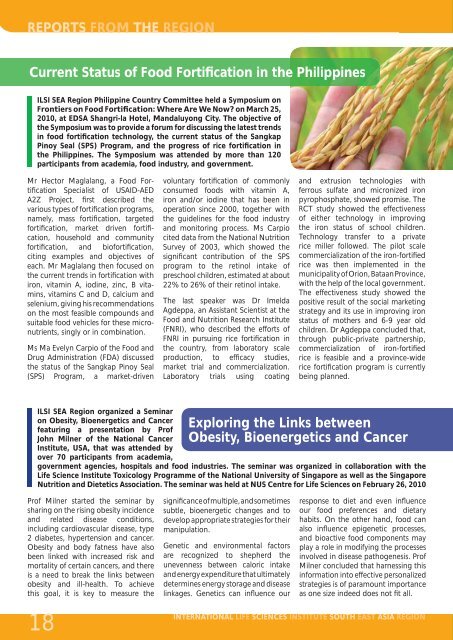ILSI Southeast Asia Region Newsletter - International Life Sciences ...
ILSI Southeast Asia Region Newsletter - International Life Sciences ...
ILSI Southeast Asia Region Newsletter - International Life Sciences ...
You also want an ePaper? Increase the reach of your titles
YUMPU automatically turns print PDFs into web optimized ePapers that Google loves.
REPORTS FROM THE REGIONCurrent Status of Food Fortification in the Philippines<strong>ILSI</strong> SEA <strong>Region</strong> Philippine Country Committee held a Symposium onFrontiers on Food Fortification: Where Are We Now? on March 25,2010, at EDSA Shangri-la Hotel, Mandaluyong City. The objective ofthe Symposium was to provide a forum for discussing the latest trendsin food fortification technology, the current status of the SangkapPinoy Seal (SPS) Program, and the progress of rice fortification inthe Philippines. The Symposium was attended by more than 120participants from academia, food industry, and government.Mr Hector Maglalang, a Food FortificationSpecialist of USAID-AEDA2Z Project, first described thevarious types of fortification programs,namely, mass fortification, targetedfortification, market driven fortification,household and communityfortification, and biofortification,citing examples and objectives ofeach. Mr Maglalang then focused onthe current trends in fortification withiron, vitamin A, iodine, zinc, B vitamins,vitamins C and D, calcium andselenium, giving his recommendationson the most feasible compounds andsuitable food vehicles for these micronutrients,singly or in combination.Ms Ma Evelyn Carpio of the Food andDrug Administration (FDA) discussedthe status of the Sangkap Pinoy Seal(SPS) Program, a market-drivenvoluntary fortification of commonlyconsumed foods with vitamin A,iron and/or iodine that has been inoperation since 2000, together withthe guidelines for the food industryand monitoring process. Ms Carpiocited data from the National NutritionSurvey of 2003, which showed thesignificant contribution of the SPSprogram to the retinol intake ofpreschool children, estimated at about22% to 26% of their retinol intake.The last speaker was Dr ImeldaAgdeppa, an Assistant Scientist at theFood and Nutrition Research Institute(FNRI), who described the efforts ofFNRI in pursuing rice fortification inthe country, from laboratory scaleproduction, to efficacy studies,market trial and commercialization.Laboratory trials using coatingand extrusion technologies withferrous sulfate and micronized ironpyrophosphate, showed promise. TheRCT study showed the effectivenessof either technology in improvingthe iron status of school children.Technology transfer to a privaterice miller followed. The pilot scalecommercialization of the iron-fortifiedrice was then implemented in themunicipality of Orion, Bataan Province,with the help of the local government.The effectiveness study showed thepositive result of the social marketingstrategy and its use in improving ironstatus of mothers and 6-9 year oldchildren. Dr Agdeppa concluded that,through public-private partnership,commercialization of iron-fortifiedrice is feasible and a province-widerice fortification program is currentlybeing planned.<strong>ILSI</strong> SEA <strong>Region</strong> organized a Seminaron Obesity, Bioenergetics and Cancerfeaturing a presentation by ProfJohn Milner of the National CancerInstitute, USA, that was attended byover 70 participants from academia,Exploring the Links betweenObesity, Bioenergetics and Cancergovernment agencies, hospitals and food industries. The seminar was organized in collaboration with the<strong>Life</strong> Science Institute Toxicology Programme of the National University of Singapore as well as the SingaporeNutrition and Dietetics Association. The seminar was held at NUS Centre for <strong>Life</strong> <strong>Sciences</strong> on February 26, 2010Prof Milner started the seminar bysharing on the rising obesity incidenceand related disease conditions,including cardiovascular disease, type2 diabetes, hypertension and cancer.Obesity and body fatness have alsobeen linked with increased risk andmortality of certain cancers, and thereis a need to break the links betweenobesity and ill-health. To achievethis goal, it is key to measure the18significance of multiple, and sometimessubtle, bioenergetic changes and todevelop appropriate strategies for theirmanipulation.Genetic and environmental factorsare recognized to shepherd theunevenness between caloric intakeand energy expenditure that ultimatelydetermines energy storage and diseaselinkages. Genetics can influence ourresponse to diet and even influenceour food preferences and dietaryhabits. On the other hand, food canalso influence epigenetic processes,and bioactive food components mayplay a role in modifying the processesinvolved in disease pathogenesis. ProfMilner concluded that harnessing thisinformation into effective personalizedstrategies is of paramount importanceas one size indeed does not fit all.INTERNATIONAL LIFE SCIENCES INSTITUTE SOUTH EAST ASIA REGION

















